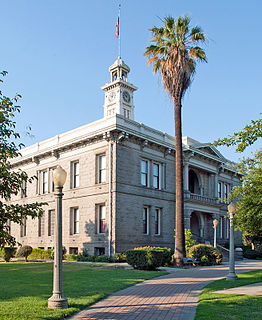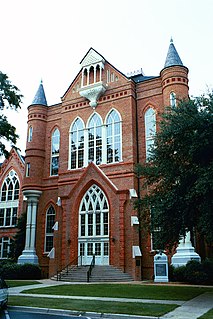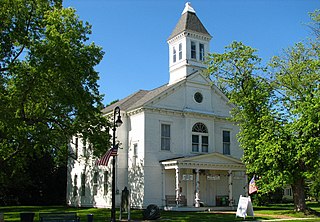
The Corydon Historic District is a national historic district located in Corydon, Indiana, United States. The town of Corydon is also known as Indiana's First State Capital and as Historic Corydon. The district was added to the National Register of Historic Places in 1973, but the listing was amended in 1988 to expand the district's geographical boundaries and include additional sites. The district includes numerous historical structures, most notably the Old Capitol, the Old Treasury Building, Governor Hendricks' Headquarters, the Constitution Elm Memorial, the Posey House, the Kintner-McGrain House, and The Kintner House Inn, as well as other residential and commercial sites.

The Old Courthouse, Warren County, also known as Warren County Courthouse, stands prominently on a hill in Vicksburg, Mississippi, and was a symbol of Confederate resistance during the Siege of Vicksburg. It was designated a National Historic Landmark in 1968 and a Mississippi Landmark in 1986. The landmarked area comprises the entire Courthouse Square, which includes the courthouse and four attached buildings that were originally cistern houses for catching rainwater to fight fires, but these were later converted into offices.

The Todd County Courthouse is the seat of government for Todd County in Long Prairie, Minnesota, United States. The hilltop courthouse was built in 1883 and is fronted by a street-level stone entryway and retaining wall constructed in 1938 by the Works Progress Administration. Additional modern buildings are set into the hill to the side and rear of the courthouse. To the southwest stood a residence for the sheriff with an attached jailhouse, built in 1900. They were extant in 1985 when the complex was listed on the National Register of Historic Places as the Todd County Courthouse, Sheriff's House, and Jail, but have been demolished since. The property was listed for having state-level significance in the themes of architecture and politics/government. It was nominated for being a good example of an Italianate public building and a long-serving home of the county government.

The Beltrami County Courthouse is a historic government building in Bemidji, Minnesota, United States. It was erected in 1902 as the seat of government for Beltrami County. District court functions relocated in 1974 to the newly completed Beltrami County Judicial Center immediately to the southwest, and the historic courthouse has been remodeled to house government offices. The old courthouse was listed on the National Register of Historic Places in 1988 for its state-level significance in the themes of architecture and politics/government. It was nominated for its status in Beltrami County as its long-serving center government and as its most prominent example of public architecture and Beaux-Arts style.

The T.G. Richards and Company Store, also known as Whatcom County Courthouse and James B. Steadman Post No. 24, is the first and oldest brick building in the state of Washington, United States, and is listed on the U.S. National Register of Historic Places.

The Jackson County Courthouse is a former county courthouse in Jacksonville, Oregon, United States, built in 1883. The courthouse is a contributing property of the Jacksonville Historic District, which is listed on the National Register of Historic Places (NRHP). It was formerly the Jacksonville Museum owned by Jackson County and operated by the Southern Oregon Historical Society (SOHS), which also managed several other historic properties in Jacksonville. The museum in the courthouse closed in 2006 because of lack of funding. Ownership of the historic courthouse was transferred to the City of Jacksonville in 2012. The SOHS still operates Hanley Farm in Central Point and a research library in Medford.

The Colfax County Courthouse in Springer, New Mexico, is a building on the National Register of Historic Places that was used as a seat of county government for Colfax County, New Mexico from 1881 until 1897. The building is located at 614 Maxwell Avenue, Springer, NM 87747, and today it houses a museum devoted to the Santa Fe Trail. The building was placed on the National Register in 1987.

The first Lincoln County Courthouse, also known as the Pioche Courthouse and the Old Lincoln County Courthouse, in Pioche, Nevada earned the title "Million Dollar Courthouse" after it cost $75,000 to build in 1872, for a relatively small building. With added costs attributed to finance charges and fiscal mismanagement, the cost in 1872 dollars came to over $800,000. The debt incurred by the county was not retired until 1938, when the new courthouse was under construction.

There are eight properties listed on the National Register of Historic Places (NRHP) in Linn County, Kansas. Two of the sites are the location of historic events. The Marais des Cygnes Massacre Site is the location of the Marais des Cygnes massacre, an 1858 event during Bleeding Kansas in which pro-slavery advocates kidnapped 11 anti-slavery settlers, killing five of them. John Brown temporarily used the site as a fort, and the property was listed on the NRHP in 1971. The Battle of Mine Creek Site preserves the location of the Battle of Mine Creek, which was fought in 1864 as part of Price's Raid during the American Civil War. Confederate general Sterling Price's army was retreating after being defeated at the Battle of Westport and was attacked by pursuing Union troops. Price's Confederate lost heavily in men and supplies. The site was added to the NRHP in 1973.

The Carroll County Court House is a historic former courthouse at 20 Courthouse Square in Ossipee, New Hampshire. Built in 1916, it is the county's oldest surviving courthouse, and a prominent local example of Colonial Revival architecture. It housed county offices until the 1970s, was a courthouse until 2004, and now houses the Ossipee Historical Society. The building was added to the National Register of Historic Places in 2007, and the New Hampshire State Register of Historic Places in 2003.

The Madera County Courthouse is the former county courthouse of Madera County, California. The courthouse is located at 210 W. Yosemite Ave. in Madera. It was built in 1900 using granite quarried within the county. The courthouse was the first significant public building constructed in Madera County. The building is topped by a clock tower; the tower fell in a 1906 fire but was rebuilt. In 1953, the county government left the courthouse, as a survey found the building to be unsafe. The Madera County Historical Society later converted the courthouse into a museum.

The Gorgas–Manly Historic District is a historic district that includes 12 acres (4.9 ha) and eight buildings on the campus of the University of Alabama in Tuscaloosa, Alabama. The buildings represent the university campus as it existed from the establishment of the institution through to the late 19th century. Two buildings included in the district, Gorgas House and the Little Round House, are among only seven structures to have survived the burning of the campus by the Union Army, under the command of Brigadier General John T. Croxton, on April 4, 1865. The other survivors were the President's Mansion and the Old Observatory, plus a few faculty residences.

The Northampton County Courthouse Historic District is a nine-acre historic district in Northampton County, Virginia, in the United States. The district is listed on the National Register of Historic Places. Three buildings are located on the property: A courthouse and a clerk's office, and a prison. The buildings house documents dating back to 1632. It is included in the Eastville Historic District.

The Montrose Historic District is a national historic district located in Montrose, Susquehanna County, Pennsylvania. The district encompasses 386 contributing buildings and two contributing sites in the central business district and surrounding residential areas of Montrose.

Kewaunee County Sheriff's Residence and Jail is a building in Kewaunee, Wisconsin, located at 613 Dodge Street on the southeast corner of the courthouse square. It was built in 1876 as the sheriff's office, residence, and county jail. The building was added to the National Register of Historic Places in 1996.

The Old Iroquois County Courthouse, now known as the Iroquois County Museum, is a history museum in Watseka, Illinois, which served as the Iroquois County courthouse from 1866 until 1964. The Italianate building was designed by C.B. Leach and built by contractor A.C. Mantor. In addition to housing county courts and offices, the building also served as the county jail and sheriff's residence. In 1881, an addition was placed on the building, and the courthouse's octagonal tower was replaced by a square tower. A second addition was constructed in 1927; in the same year, the courthouse's copper dome was removed and replaced by a mansard roof.

The Second Arenac County Courthouse, also known as Ye Olde Courthouse Masonic Hall and the Omer Masonic Hall, is a historic building located on Central Avenue in Omer, Michigan. The building is an outstanding example of a highly detailed vernacular frame building. It was designated a Michigan State Historic Site in 1976 and listed on the National Register of Historic Places in 1982.

The Former Audubon County Courthouse, also known as the Audubon County Historical Society Museum, is a historic building located in Exira, Iowa, United States. Court proceedings were first held in a schoolhouse in Hamlin's Grove after Audubon County was established in 1851. The county seat was relocated to Exira ten years later, and a disagreement erupted over where the county seat should be located. The county board of supervisors made an appropriation for a new courthouse in 1871, but its construction was delayed due to the disagreement. Exira eventually won and officials constructed the courthouse for about $2,200. The Exira Hall Company was established to build the two-story, frame structure. County offices were located on the first floor and the courtroom was located on the second floor. The county seat was moved to Audubon in 1879.

The Courthouse Square Museum is a former government building, and current historical museum, located at 100 West Lawrence Avenue in Charlotte, Michigan. It was listed on the National Register of Historic Places in 1971.





















